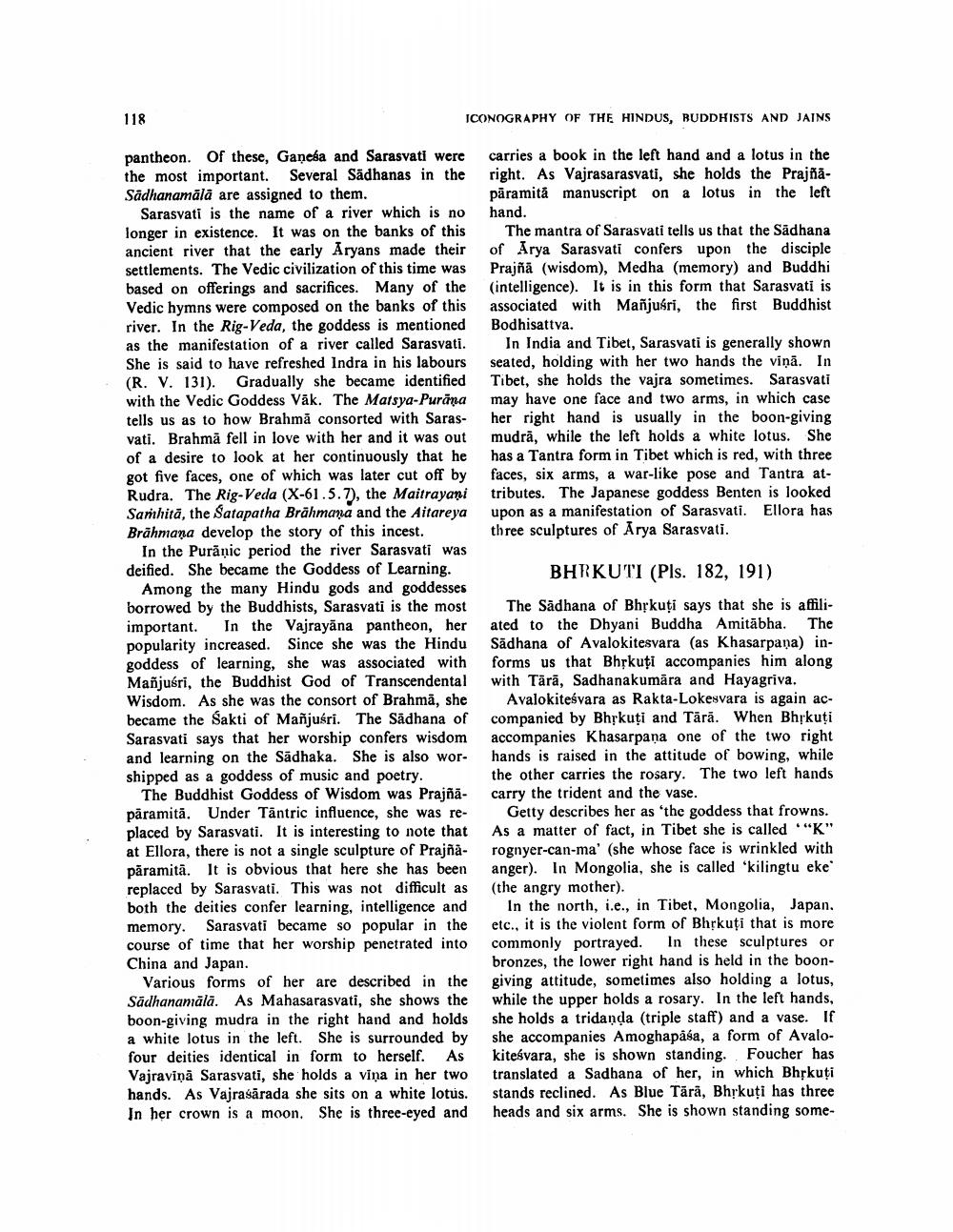________________
118
ICONOGRAPHY OF THE HINDUS, BUDDHISTS AND JAINS
pantheon. of these, Ganeba and Sarasvati were carries a book in the left hand and a lotus in the the most important. Several Sadhanas in the right. As Vajrasarasvati, she holds the PrajñāSadhanamāla are assigned to them.
pāramită manuscript on a lotus in the left Sarasvati is the name of a river which is no hand. longer in existence. It was on the banks of this the mantra of Sarasvati tells us that the Sadhana ancient river that the early Aryans made their of Arya Sarasvati confers upon the disciple settlements. The Vedic civilization of this time was Prajñā (wisdom), Medha (memory) and Buddhi based on offerings and sacrifices. Many of the intelligence). It is in this form that Sarasvati is Vedic hymns were composed on the banks of this associated with Manjusri, the first Buddhist river. In the Rig Veda, the goddess is mentioned Bodhisattva. as the manifestation of a river called Sarasvati. In India and Tibet, Sarasvati is generally shown She is said to have refreshed Indra in his labours seated, holding with her two hands the viņā. In (R. V. 131). Gradually she became identified Tibet, she holds the vajra sometimes. Sarasvati with the Vedic Goddess Vāk. The Matsya-Purāna may have one face and two arms, in which case tells us as to how Brahmă consorted with Saras- her right hand is usually in the boon-giving vati. Brahma fell in love with her and it was out mudrā, while the left holds a white lotus. She of a desire to look at her continuously that he has a Tantra form in Tibet which is red, with three got five faces, one of which was later cut off by faces, six arms, a war-like pose and Tantra atRudra. The Rig Veda (X-61.5.7), the Maitrayani tributes. The Japanese goddess Benten is looked Samhita, the Satapatha Brāhmana and the Aitareya upon as a manifestation of Sarasvati. Ellora has Brähmana develop the story of this incest. three sculptures of Arya Sarasvati.
In the Pură nic period the river Sarasvati was deified. She became the Goddess of Learning.
BHRKUTI (Pls. 182, 191) Among the many Hindu gods and goddesses borrowed by the Buddhists, Sarasvati is the most The Sadhana of Bhrkuţi says that she is affiliimportant. In the Vajrayāna pantheon, herated to the Dhyani Buddha Amitabha. The popularity increased. Since she was the Hindu Sadhana of Avalokitesvara (as Khasarpana) ingoddess of learning, she was associated with forms us that Bhrkuţi accompanies him along Manjusri, the Buddhist God of Transcendental with Tärā, Sadhanakumāra and Hayagriva. Wisdom. As she was the consort of Brahma, she Avalokitesvara as Rakta-Lokesvara is again acbecame the Sakti of Manjusri. The Sadhana of companied by Bhşkuți and Tärä. When Bhrkuți Sarasvati says that her worship confers wisdom accompanies Khasarpana one of the two right and learning on the Sadhaka. She is also wor- hands is raised in the attitude of bowing, while shipped as a goddess of music and poetry.
the other carries the rosary. The two left hands The Buddhist Goddess of Wisdom was Prajñā. carry the trident and the vase. päramită. Under Tantric influence, she was re- Getty describes her as 'the goddess that frowns. placed by Sarasvati. It is interesting to note that As a matter of fact, in Tibet she is called "K" at Ellora, there is not a single sculpture of Prajna- rognyer-can-ma' (she whose face is wrinkled with pāramitā. It is obvious that here she has been anger). In Mongolia, she is called 'kilingtu eke replaced by Sarasvati. This was not difficult as (the angry mother). both the deities confer learning, intelligence and In the north, i.e., in Tibet, Mongolia, Japan. memory. Sarasvati became so popular in the etc., it is the violent form of Bh;kuți that is more course of time that her worship penetrated into commonly portrayed. In these sculptures or China and Japan.
bronzes, the lower right hand is held in the boonVarious forms of her are described in the giving attitude, sometimes also holding a lotus, Sadhanamāla. As Mahasarasvati, she shows the while the upper holds a rosary. In the left hands, boon-giving mudra in the right hand and holds she holds a tridanda (triple staff) and a vase. If a white lotus in the left. She is surrounded by she accompanies Amoghapåsa, a form of Avalofour deities identical in form to herself. As kitesvara, she is shown standing. Foucher has Vajraviņā Sarasvati, she holds a vina in her two translated a Sadhana of her, in which Bhşkuţi hands. As Vajrasärada she sits on a white lotus. stands reclined. As Blue Tärå, Bhrkuți has three In her crown is a moon. She is three-eyed and heads and six arms. She is shown standing some
WITH




